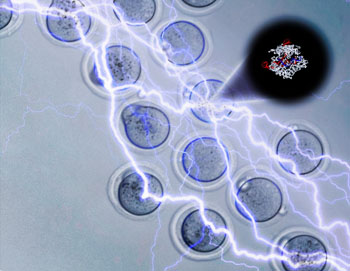Rapid Injection Technique Improves Production of Genetically Engineered Mice
By LabMedica International staff writers
Posted on 06 Jun 2016
An electroporation method has been introduced that improves the production of genetically altered "knock-out" mice by requiring less time and being more efficient at introducing the CRISPR-Cas9 genome editing complex than is the current microinjection method.Posted on 06 Jun 2016
CRISPRs (clustered regularly interspaced short palindromic repeats) are segments of prokaryotic DNA containing short repetitions of base sequences. Each repetition is followed by short segments of "spacer DNA" from previous exposures to a bacterial virus or plasmid. CRISPRs are found in approximately 40% of sequenced bacteria genomes and 90% of sequenced archaea. CRISPRs are often associated with cas genes that code for proteins related to CRISPRs. The CRISPR/Cas complex comprises a prokaryotic immune system that confers resistance to foreign genetic elements such as plasmids and phages and provides a form of acquired immunity. Since 2013, the CRISPR/Cas system has been used in research for gene editing (adding, disrupting, or changing the sequence of specific genes) and gene regulation. By delivering the Cas9 protein and appropriate guide RNAs into a cell, the organism's genome can be cut at any desired location. The conventional CRISPR-Cas9 system is composed of two parts: the Cas9 enzyme, which cleaves the DNA molecule and specific RNA guides (CRISPRs) that shepherd the Cas9 protein to the target gene on a DNA strand.

Image: Electroporation jolts embryos with electricity to open holes that allow the CRISPR-Cas9 molecule (lower right) to enter and edit the DNA (Photo courtesy of Dr. Andrew Modzelewski, Dr. Lin He, University of California, Berkeley).
CRISPR-mediated mouse genome editing is typically accomplished by microinjection of Cas9 DNA/RNA and single-guide RNA into zygotes to generate modified animals in one step. However, microinjection is a technically demanding, labor-intensive, and costly procedure with poor embryo viability. In practice, the microinjection method requires inoculation of individual cells or embryos with two RNA molecules - messenger RNA (mRNA), which codes for the Cas9 protein, and guide RNA, which provides the address for CRISPR-Cas9's target. In only a small percentage of cells the mRNA is properly translated into Cas9 protein, and the protein correctly combines with the guide RNA.
Electroporation relies on a burst of electricity to create holes in cells or embryos through which molecules can enter. Investigators at the University of California, Berkeley (USA) recently described a novel adaptation of the technique, which they called CRISPR-EZ (CRISPR RNP Electroporation of Zygotes). They described this simple and cost-effective methodology, which can be performed on many embryos at once and takes only milliseconds to perform in the May 5, 2016, online edition of the Journal of Biological Chemistry.
Using CRISPR-EZ, which could deliver Cas9/sgRNA ribonucleoproteins (RNPs) into mouse zygotes with 100% efficiency, the investigators generated a variety of editing schemes in mouse embryos, including indel (insertion/deletion) mutations, point mutations, large deletions, and small insertions. In a proof-of-principle experiment, they used CRISPR-EZ to target the Tyrosinase (Tyr) gene, achieving 88% bi-allelic editing and 42% Homology-Directed Repair (HDR)-mediated precise sequence modification in live mice.
"The key fundamental insights about the biological significance of a gene usually come from in vivo gene-editing studies, in which you generate mice with an altered gene," said senior author Dr. Lin He, a associate professor of molecular and cell biology at the University of California, Berkeley. "But it is a major commitment to make a novel knockout with genome engineering. I think this technology could greatly reduce the technical barrier for this type of effort and will allow people to focus more on the science rather than be consumed by the process of genetically engineering mice."
"The actual percentage of live births from injected embryos is around 10 to 15% for most transgenic facilities, which is a problem with the procedure," said Dr. He. "Sometimes people collect more than 100 embryos just to generate one or two mice with desirable gene editing. Electroporation appears to do less damage to the embryos than microinjection: between 30% and 50% of the embryos resulted in live births."
Related Links:
University of California, Berkeley














